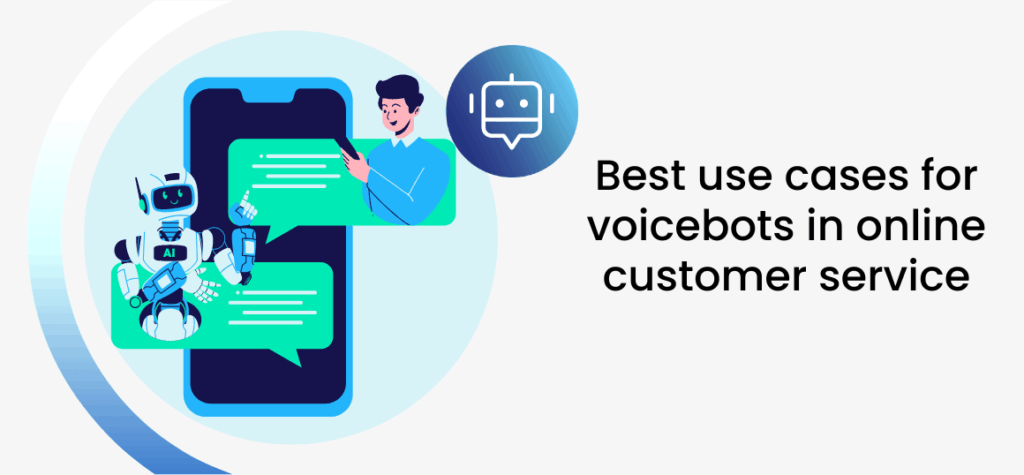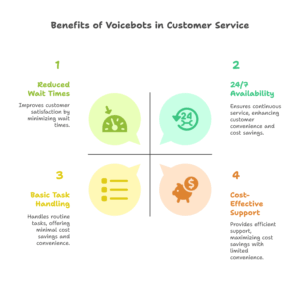Best use cases for voicebots in online customer service

How does a voice assistant improve customer communication? Proven use cases
In the world of online customer service, more and more processes can be automated—but not every solution performs equally well. Voice bots are one of those tools that not only take over some of the duties of customer service agents but do so in a way that closely resembles human conversation. They work quickly, don’t need breaks, and can respond to user needs in real time. The goal isn’t to replace humans—it’s to help customers handle their issues efficiently, without unnecessary steps or long waiting times.
Technologies behind voicebots: speech, context, and security
Modern voicebots rely on three key technologies that enable them to conduct conversations in a clear, natural, and secure way. Below are their main features:
- Speech Recognition (ASR – Automatic Speech Recognition)
Thanks to this technology, the bot can convert the user’s spoken input into text that the system can interpret. Today’s ASR engines are capable of recognizing different accents, speech speeds, and regional pronunciations. The algorithms are trained on large linguistic datasets, allowing for increasingly accurate adaptation to local dialects and speaking styles. - Natural Language Understanding (NLU)
This technology allows the bot not just to recognize words, but also to interpret their meaning. By using machine learning, the system can analyze user intent, understand context, and learn how to better respond to unconventional inputs. Voicebots equipped with NLU can carry on conversations in a logical way—even if the user’s statement doesn’t exactly match the predefined script. As a result, the interaction becomes smoother, more human-like, and less “template-based.” - Security and data protection
Voicebots, such as those offered by EasyCall, operate in compliance with GDPR, encrypt data transmissions (e.g., TLS 1.2), and support voice or PIN-based authorization. Call recordings are stored in ISO/IEC 27001-compliant cloud environments, and access to customer data is controlled and audited. All this ensures that the voicebot not only “listens and speaks” but does so responsibly and in line with data privacy standards.
Benefits of using voicebots in customer service
Voice bots are currently enjoying widespread popularity as the first point of contact with customers—and for good reason. They operate quickly and can take over many tasks that previously required human involvement. Voicebots that handle an average of 60–80% of inquiries without human assistance can significantly reduce wait times and lower operational costs by up to 30%. This creates a win-win situation for both sides.
Less routine for employees, more convenience for customers
Voicebots can take over many tedious and repetitive tasks that often fall on customer service representatives. Thanks to them, agents no longer have to answer the same frequently asked questions—like order status or opening hours—for the hundredth time. Instead, they can focus on more complex cases that truly require a human touch. For companies, this means saving time and energy—and for customers? Faster responses and less time spent on hold.

Available around the clock – even in the middle of the night
One of the biggest advantages of voice bots is their 24/7 availability. Whether a customer calls at 3 a.m. or during a holiday, the voicebot will answer and try to help. In many industries—especially those where quick response times are critical—this kind of availability makes a huge difference. Customers no longer have to wait until Monday to resolve an issue; a short conversation with the bot is often enough to resolve the problem immediately.
Lower costs, greater capabilities
Implementing voice bots also translates to tangible cost savings. Instead of hiring more staff to answer phones, companies can invest in technology that handles basic support just as effectively. What’s more, voicebots are becoming increasingly adept at “understanding” the customer—they can recognize who they’re talking to, recall past interactions, and even adjust their tone accordingly. This makes even an automated conversation feel surprisingly human.
Top use cases for voicebots in online customer service
Where do voicebots perform best, and in which areas do they truly make life easier for customers? Here’s a quick overview.
Registering inquiries and complaints
Voicebots are highly effective at handling customer inquiries and complaints—especially when customers expect a quick response without waiting for a live agent. The bot can guide the user step by step to gather essential information such as a description of the issue, date of the incident, or order number, and then pass it along in a structured format. The key is to keep the conversation simple and logical, with no unnecessary complexity. This gives the customer a sense that their issue has been acknowledged, while the company receives all the necessary data to efficiently handle the case.
Voicebots in healthcare – more than just automated scheduling
The healthcare sector is a particularly promising area for voicebot applications. Voicebots not only handle appointment scheduling and reminders for check-ups, but are increasingly being used as preliminary diagnostic tools and lead generators—especially for private medical facilities.
An example? The bot can conduct a brief medical survey in which the user answers questions about their well-being, symptoms, or existing conditions. Based on the responses, the system can recommend a consultation with a specialist, suggest preventive screenings, or propose service packages—generating actual sales leads and converting them into paid visits. These solutions actively support marketing and sales efforts, making the voicebot not just a service channel but a valuable partner in increasing clinic revenue.
Porozmawiaj z naszym specjalistą
An added benefit is automatic reporting of the conversation’s outcome and sending the data to CRM systems or directly to the sales team, enabling fast follow-up actions such as preparing offers, sending SMS reminders, or scheduling a callback.
Order tracking with voicebots and dedicated shopping bots
Voicebots make it easy for customers to quickly check the status of their orders—without logging in or waiting on hold. By integrating with logistics systems (such as DHL, InPost, or DPD), the bot provides real-time updates, allowing users to access shipment information anytime they need. Increasingly, this feature is also built into shopping apps, enabling users to activate the voicebot directly within the app—bypassing forms and text chats. This saves time and offers greater convenience for customers who want instant access to their order details, anytime, anywhere.
Scheduling appointments and reservations
Booking a doctor’s appointment, a haircut, or a courier visit is one of those tasks that often take more time than they should. A voicebot can assist the customer in selecting a convenient time slot, checking availability, and confirming the booking right away—without the need to transfer the call, send emails, or wait for a callback. It’s helpful when the bot gives the customer a choice—whether to select from a list or simply say the preferred day and time. These small touches significantly improve the overall user experience.
Voicebots in unexpected industries
While voicebots are commonly associated with e-commerce or healthcare, they’re also making inroads into highly specialized sectors including space and advanced engineering. In research environments where precision, safety, and automation are paramount, voicebots are used to assist in logging experiments, reporting anomalies, or guiding technicians through complex procedures in clean rooms or high-risk environments. For example, engineers working on satellite assembly or space simulation projects can use voice commands hands free to navigate checklists or request documentation, reducing the need for physical interaction with devices and improving operational efficiency. These applications demonstrate how flexible and industry agnostic voice technology has become, finding its place even in the most cutting-edge domains.

First-line technical support
When something isn’t working and the customer isn’t sure why, a voicebot can ask a few simple questions to help identify the issue. It might suggest a quick reboot, check settings, or offer common troubleshooting tips. Often, the problem can be resolved without involving a human agent—just through a well-guided conversation. And if the issue is more complex, the bot can still gather all the relevant data to help a specialist assist the customer more efficiently.
Collecting feedback after contact
Voicebots are excellent tools for gathering customer feedback right after a call or service interaction. They can naturally ask the customer to rate their experience—on a scale from 1 to 5, for example—or pose a brief open-ended question like “What could we improve?” Thanks to automation, this process doesn’t require human involvement while still collecting valuable insights. It’s essential that the questions are short and clear—this encourages more responses, giving companies meaningful data to analyze and improve. What’s more, automated feedback collection can generate 3–5 times more responses than traditional email surveys.
Integrating voicebots with other communication channels
Voicebots become significantly more effective in customer service when they’re integrated with other communication channels, creating a seamless and consistent user experience. This is where the omnichannel approach comes in—allowing customers to move fluidly between different forms of contact: voice conversations, chatbots, email, or mobile apps. Thanks to such integration, customers don’t need to repeat the same information every time they switch channels—a voicebot can “pick up” from where the previous interaction left off.
From a technical perspective, integrating voicebots with CRM systems, databases, websites, or IVR (Interactive Voice Response) systems enables centralized information management and more flexible service. As a result, the voicebot is no longer just a standalone tool, but becomes part of a larger, intelligent customer contact ecosystem. A well-integrated voicebot offers not just convenience—but a true competitive advantage.
Real-time customer support? Discover what EasyCall voicebots can do
Voice bots are no longer a futuristic novelty—they’re a practical tool that more and more companies are implementing to achieve a clear benefit: faster, more cost-effective, and more accessible customer service. Their effectiveness depends not only on the underlying technology but also on thoughtful application—where they replace repetitive tasks, streamline processes, and improve the overall customer experience.
If you’re looking for a proven solution that can truly ease the workload of your team while enhancing the quality of customer support, EasyCall is a choice worth considering. The company offers modern voice bots that can be easily tailored to the specific needs of your industry and implemented without unnecessary hassle. Organizations like the Copernicus Science Centre and the Gizińscy Medical Center have already seen the benefits firsthand.
